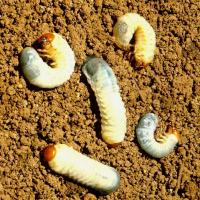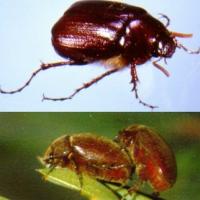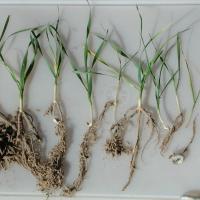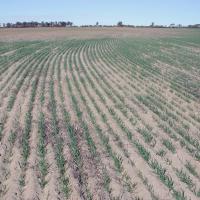Diagnosing cockchafers
Cockchafer larvae feed underground on organic material with some species also serious pests of cereals. There are a number of species that are found in WA, however, only a few actually cause crop damage. Cockchafer larvae can be found in high numbers and not cause crop damage.
What to look for
- Larvae found only in soil and are up to 12 millimetres long, creamy-white with a darker head and curled into a ‘C’ shape.
Insect Larvae
- Larvae feed on underground plant parts, causing them to wither and die potentially leading to large bare areas. Crops after pasture are more likely to be damaged with damage worse near tree belts.
Paddock
What else could it be
| Condition | Similarities | Differences |
|---|---|---|
| Diagnosing African black beetle | C-shaped grubs and young plant death from chewed roots and crowns. | African black beetle adults continue to chew plants throughout the season, fraying the lower stem and often only affecting individual tillers. |
| Diagnosing sandgropers | Early plant death from chewed roots and crowns | Sandgropers are large cricket-type insects that cause damage in the West Midlands, continue to chew plants throughout the season and fray the lower stem. |
Where did it come from?
- Cockchafers are native insects that occasionally reach damaging levels when conditions favour adult egg laying.
- The complete life cycle may take one or two years. Some species have a long larval stage which extends over 12 - 18 months.
- In most species the larva is active during late autumn and winter, then pupate in spring with adults emerging in early summer. Feeding, mating and egglaying may occur throughout summer.
Management strategies

Seed treatment
- Cockchafers cannot be successfully controlled post crop emergence with insecticides as they stay underground.
- Insecticides can be mixed with seed or a higher seeding rate used if paddocks are known to have high populations of cockchafers.
Economic and financial considerations
To assist in assessing the economic risk and financial costs associated with various treatment strategies go to MyEconomicTool
There may be other economic and financial implications that need to be considered when choosing a management option. These may include:
Pre-crop- Assess whether cockchafers/larvae exist in the soil in damaging numbers.
- Understand the potential yield losses associated with cockchafer feeding damage.
- Assess the costs and benefits of taking preventative action
- Compare the costs, benefits and risk of each management option against doing nothing.
- Ignore all previous treatment and sowing costs in assessing current management options.
- Consider the costs of continuing monitoring and treatment.
View these economic considerations in more detail.
How can it be monitored?
- It is difficult to monitor cockchafers before seeding.
- Check newly-emerged crops for underground damage and the presence of larvae in the soil.
See also
Page last updated: Friday, 17 April 2015 - 11:23am





